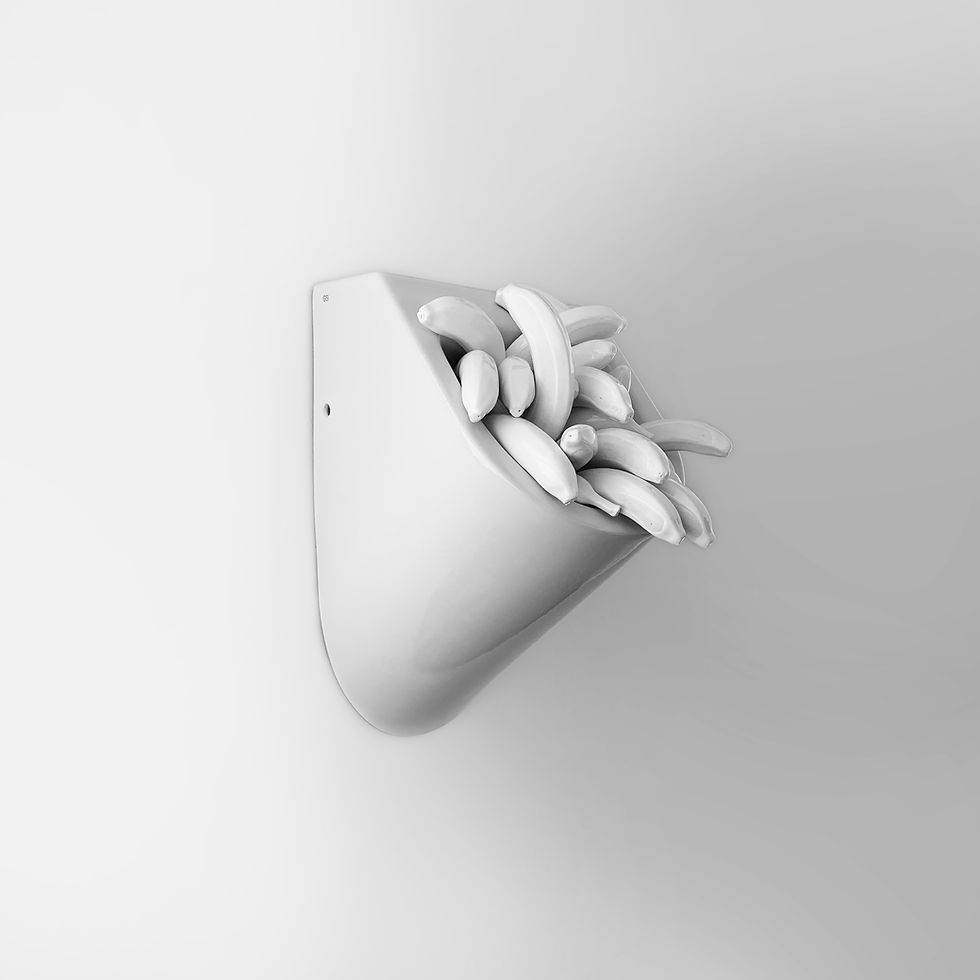Fruit machine
- ArtZone

- Sep 27, 2023
- 3 min read
By Sophie Carter
Oliver Cain’s bananas get about. They protrude from picture frames, hang from trees, explode from urns and milk cartons – gallery-goers may even discover one on trips to the loo.

There’s a lot to digest in Oliver Cain’s work. At first glance his ceramics, sculptures, and paintings are amusing and whimsical, but peeling back the skin we find a pulp ripe with narratives.
Art that makes you stop and think is important,” says Cain. “Work that can be viewed on the surface for what it is and also hold its own when it is pulled apart and the ideas behind it explored.”
Cain is a proud member of the queer community, and much of his work speaks of sexuality, identity, gender, and queer storytelling. “My work seeks to centre representation and desire as the building blocks of our inclusive future.”
The artist brings these themes to light “using appropriated everyday objects to transform stereotypes” – the most prevalent of them – the humble banana. It’s a delicious, cheap addition to most people’s fruit bowls, with a phallic quality not even complete prudes can deny.

The eggplant (the phallic symbol of the emoji age) also gets a ceramic. In Cain’s Supermarket Series they’re piled high in a shopping trolley, a physical representation of a person’s accumulated sexual history, and a warning about “settling for subpar love when tired or hungry.”
Cain uses fruit to handle serious topics with a light touch and also taps into uncomfortable similarities shared with food – the human body is also organic matter, and like a banana or an eggplant, decays, bruises, and has a sell-by-date.
Since 2022 Cain’s bananas have been popping up in some unlikely places. His ongoing Banana Urinal Project involves sneakily placing ceramic bananas in urinals at renowned galleries, including at London’s Tate Modern, the Getty in LA, and the Met in New York, among others. Although Cain has yet to hear from lucky finders of the bananas he says “It’s fun saying I’ve had work in some of the largest art galleries in the world.”

Last year Cain’s bananas peaked in scale, taking to the stage at World of Wearable Art (WOW). His all-white banana-shaped dress, A Peeling Misconception, received second place in the competition’s Monochromatic section. “I wanted to make an outfit that was an extension of my art practice,” says Cain. “The banana theme was a must and the final design was a large version of one of my banana-covered bowls.”
Made from plywood and fibreglass, the dress was covered in polystyrene bananas and finished with car paint to give the impression of a glossy glazed ceramic. Cain will be entering WOW again this year, working with recycled materials.
The Monochromatic category was ideal for Cain, who has always worked with a limited palette. “I make lots of my work a glossy white to contrast the narrative which I’m exploring,” he explains. “It’s a juxtaposition of the stigma that parts of the queer community are viewed as dirty and unclean, with my work which is almost clinically clean.”
LEFT: Oliver Cain, Banana Urn, ceramic urns with banana forms and ostridge feathers, 2022. RIGHT: Oliver Cain, A Peeling Misconception, wood, fibreglass & polystyrene, 2021/22
Considering the subject matter he explores, it’s interesting to learn that Cain was brought up in a devout Christian household. British-born, he lived in England until 2013 when his family emigrated to Aotearoa. “Growing up I had to navigate my sexuality within that religious framework,” says Cain. “My family is very supportive and are always interested to see what I’m working on. They don’t understand some of my work and that’s okay. Art is subjective, even when family makes it.”
When Cain started his Fine Arts degree at Unitec Institute of Technology in Auckland, he used his personal story to shape his practice. “It was a great source of therapy for me, and as a result I created work that I was excited by, and others related to.” It was also at art school that Cain fell in love with clay, discovering slip casting, a technique he employs for most of his ceramics. “It allowed me to make lifelike objects which I could edit and manipulate as I pleased.”

Now living in Takapuna, Cain works from his garage, a space which he’s beginning to outgrow. “I have my kiln to make my ceramic works, and canvases, and boxes of work in most available spaces throughout the house.” Thankfully some pieces he’s currently working on will soon be heading to New Mexico for an exhibition there. “I can’t wait to have a dedicated studio space to do more experimenting and creating.”
First published in ArtZone #95









Comentarios